Prospective Design and Evaluation of a Renewable Energy Hybrid System to Supply Electrical and Thermal Loads Simultaneously with an Electric Vehicle Charging Station for Different Weather Conditions in Iran
Abstract
Highlights
- Planning and functioning of hybrid renewable energy sources in different locations function of main grid presence, available local renewable energy sources, and small-scale classical sources to balance simultaneously electrical and thermal loads.
- Modeling and optimization of nine location designs for electric vehicles charging stations under specific renewable energy sources locally available.
- Optimal configuration of EVs in planning hybrid renewable energy systems.
- Analysis of proposed various configurations under different climate conditions: cold/mountain, hot/arid climate, hot/humid, moderate/sea climates.
Abstract
1. Introduction
1.1. Microgrid Configuration and Architecture
1.1.1. Hybrid Renewable Energy Sources
1.1.2. Electric Vehicle Charging Stations
1.2. Literature Review
1.2.1. Hybrid Renewable Energy Sources
1.2.2. Electric Vehicle Charging Stations
1.3. Research Gap
- Typically, both electrical and thermal energy are consumed concurrently in various usage zones. Nonetheless, there is a limited amount of research addressing the concurrent provision of different types of energy, including renewables, within IHRESs. Heating requirements are frequently fulfilled using non-renewable sources like conventional boilers.
- Furthermore, most studies examined only a restricted range of design possibilities, overlooking a comprehensive analysis of all potential designs.
- As a pragmatic and effective approach for mitigating environmental pollution, the adoption of EVs is rapidly gaining traction in modern society. Since EV batteries require charging from the power grid, they should be regarded as a unique category of consumer and/or storage device. It is worth mentioning that the inclusion of EVs in the planning phase of IHRESs, considering diverse geographical and climatic factors, has received less attention in recent research endeavors.
- Only a limited number of scientific papers have explored the influence of EV demand and charging patterns on the optimization of IHRESs design.
1.4. Contributions
- Suggesting an effective approach to plan the capacity and optimal functioning of a IHRESs linked to the grid, incorporating RESs, CHP, and a boiler. This system is designed to simultaneously fulfill the electricity and thermal requirements of a tourist resort complex, including the changing needs of EVs, all while minimizing the overall cost. This planning is executed through the utilization of HOMER GRID modeling and optimization tools.
- Evaluation of the optimal design of IHRESs performance concerning different factors such as costs (NPC, energy cost, initial cost, and operating cost) and emissions (CO2 pollution, fuel consumption).
- The research involves modeling and optimizing nine distinct designs for charging/refueling stations, considering the renewable resources accessible in the specified city.
- A suggested optimal energy configuration for a dependable EVCS integrates renewable energy sources and a national network. The proposal is based on a thorough examination of various discrete locations chosen as case studies. To the authors’ knowledge, no prior study has explored such detailed and diverse considerations in the mentioned locations.
- Among the strategies, one sample pertains to Ahvaz, sharing similarities in climate with Arab nations around the Persian Gulf. Additionally, another strategy focuses on Ardabil, mirroring the climate of countries such as Azerbaijan and Armenia. Consequently, this study offers a foundational framework applicable to multiple countries.
2. Methods and Input Data
2.1. Input Location Data and Meteorology for IHRES
2.1.1. Location
- Ardabil, Hamadan, Shahrekord, and Mashhad (Binalud), characterized by cold and mountainous climates;
- Yazd and Kerman, known for hot and arid climates;
- Ahvaz, experiencing hot and humid conditions;
- Gilan (Manjil), featuring a moderate and humid Caspian climate;
- Tehran, with a moderate climate.
2.1.2. Meteorological Data
2.1.3. Electrical and Thermal Load
2.2. Component of the HRES
2.2.1. PV Array
2.2.2. WT
2.2.3. BESS
2.2.4. Disel Generator (CHP)
2.2.5. Boiler
2.2.6. Converter
2.2.7. TLC
2.2.8. Electric Vehicles Charge Station (EVCS)
2.3. Economic and Technical Data
3. Optimization Method and Energy Management Strategy
4. Simulation Results and Discussion
4.1. Technical Analysis
4.2. Economic Analysis
4.3. EVCS Analysis
4.4. Analysis of Energy Policy and Environmental Considerations
5. Conclusions, Limitation, and Future Work
5.1. Conclusions
- Given Iran’s vast gas and oil resources, most of the country’s electrical energy is produced by combustion fossil fuels. Consequently, developing an environmentally optimized RES solution presents a more practical alternative than simply expanding the existing grid.
- Another key finding of the proposed method is achieving the maximum count of occurrences of charging times, with an average of only 0.1 sessions per day where a customer might be unable to charge their EV. Very few sessions were missed on days when EVs were properly scheduled using the proposed model.
- Another noteworthy point is the impact of heat on electricity production by PVs. In scenarios 2 and 5, both locations receive a similar amount of sunlight, but the PV output in scenario 2 is about 9.8% higher than in scenario 5.
- When comparing the highest and lowest NPCs (from scenarios 7 and 2), there is a 12.95% increase, primarily due to the use of more WTs in scenario 7. This suggests that, given Iran’s geographical conditions, using PVs is generally more cost-effective and productive than WTs in most areas of the country.
- Analyzing the initial costs of different configurations reveals a 62.37% difference between the highest and lowest values, mainly due to the high costs associated with WTs.
- Incorporating diesel generators into HRESs reduces the need to purchase electricity from the grid, especially in regions like Iran where diesel-based electricity production is cost-effective and fuel prices are stable, thus lowering NPC and COE.
- The impact of sensitivity variables on costs depends on the values of other sensitivity variables in each case.
- Although the suggested method and sizing analysis were implemented for several case study in Iran, this strategy and it is findings can be applied worldwide, taking into account location-specific geographical features and climatic data (such as WS and solar radiation).
- The economic advantages of the RES system at the charging station offer social welfare for EV owners and environmental advantages, such as lower COE for EV charging and reduced GHG emissions. Therefore, investing in an HRES microgrid for the EV sector is valuable in the long term. Further, interaction among EVs opens a new field of study with significant potential for future research.
5.2. Limitations and Future Work
Author Contributions
Funding
Data Availability Statement
Conflicts of Interest
Nomenclature
| Abbreviations | |
| RES | Renewable energy source |
| HRES | Hybrid renewable energy source |
| WT | Wind turbine |
| PV | Photovoltaic |
| DG | Diesel generator |
| TLC | Thermal load controller |
| GHG | Greenhouse gases |
| EV | Electric vehicle |
| EVCS | Electric vehicle charge station |
| NPC | Net present cost |
| COE | Cost of energy |
| BESS | Battery energy storage system |
| CRF | Capital recovery factor |
| Parameters and variables | |
| PPV | Output power PV |
| PWT | Output power WT |
| PDG | Output power DG (CHP) |
| PBESS | Output power BESS |
| PGRID | Power grid |
| MP | Modules parallel |
| MS | Modules series |
| Pmodule | Power module |
| Efficiency MPPT | |
| Output efficiency | |
| Air density | |
| A | Cross section |
| Vcut-in | Low cutting speed |
| Vcut-off | High cutting speed |
| Vr | Rated speed |
| CWT | WT power coefficient |
| annual real interest rate | |
| nominal interest rate | |
| inflation rate | |
| Pch | Power charge BESS |
| Pdch | Power discharge BESS |
| Charge efficiency | |
| Discharge efficiency | |
| SOC | State of charge |
| Hchp | Thermal power |
| LHV | Lower heating value |
| Inverter efficiency | |
| Rectifier efficiency | |
| Ccap | Capital cost |
| Crep | Replacement cost |
| CO&M | O&M cost |
| Cfuel | Fuel cost |
| Cgrid | Grid cost |
| PN | Total power in year |
References
- Batista, N.E.; Carvalho, P.C.; Fernández-Ramírez, L.M.; Braga, A.P. Optimizing methodologies of hybrid renewable energy systems powered reverse osmosis plants. Renew. Sustain. Energy Rev. 2023, 182, 113377. [Google Scholar]
- Ayan, O.; Turkay, B.E. Techno-Economic comparative analysis of grid-connected and islanded hybrid renewable energy systems in 7 climate regions, Turkey. IEEE Access 2023, 11, 48797–48825. [Google Scholar]
- Altin, C. Investigation of the effects of synthetic wind speed parameters and wind speed distribution on system size and cost in hybrid renewable energy system design. Renew. Sustain. Energy Rev. 2024, 197, 114420. [Google Scholar] [CrossRef]
- Khaled, O.; Zahid, M.; Zahid, T.; Ilahi, T. Techno-Economic Feasibility of Hybrid Energy Systems Installation in Pakistan. IEEE Access 2024, 12, 41643–41658. [Google Scholar]
- Available online: https://www.iea.org/countries/iran/energy-mix (accessed on 27 March 2025).
- Motamedisedeh, O.; Omrani, S.; Karim, A.; Drogemuller, R.; Walker, G. A comprehensive review of optimum integration of photovoltaic-based energy systems. Renew. Sustain. Energy Rev. 2025, 207, 114935. [Google Scholar]
- He, Y.; Guo, S.; Dong, P.; Zhang, Y.; Huang, J.; Zhou, J. A state-of-the-art review and bibliometric analysis on the sizing optimization of off-grid hybrid renewable energy systems. Renew. Sustain. Energy Rev. 2023, 183, 113476. [Google Scholar]
- Xing, K.; Luo, L.; Lu, S.; Gu, W.; Wang, X.; Bai, Y. Improve operational flexibility of distribution systems using transportable resources. Renew. Sustain. Energy Rev. 2024, 204, 114788. [Google Scholar]
- Balaban, G.; Lazaroiu, G.; Dumbrava, V.; Sima, C. Analysing Renewable Energy Source Impacts on Power System National Network Code. Inventions 2017, 31, 1–18. [Google Scholar]
- Bahramara, S.; Moghaddam, M.P.; Haghifam, M. Optimal planning of hybrid renewable energy systems using HOMER: A review. Renew. Sustain. Energy Rev. 2016, 62, 609–620. [Google Scholar]
- Baruah, A.; Basu, M.; Amuley, D. Modeling of an autonomous hybrid renewable energy system for electrification of a township: A case study for Sikkim, India. Renew. Sustain. Energy Rev. 2021, 135, 110158. [Google Scholar]
- Silinto, B.F.; van der Laag Yamu, C.; Zuidema, C.; Faaij, A.P. Hybrid renewable energy systems for rural electrification in developing countries: A review on energy system models and spatial explicit modelling tools. Renew. Sustain. Energy Rev. 2025, 207, 114916. [Google Scholar] [CrossRef]
- Mahesh, A.; Sandhu, K.S. Hybrid wind/photovoltaic energy system developments: Critical review and findings. Renew. Sustain. Energy Rev. 2015, 52, 1135–1147. [Google Scholar] [CrossRef]
- Upadhyay, S.; Sharma, M. A review on configurations, control and sizing methodologies of hybrid energy systems. Renew. Sustain. Energy Rev. 2014, 38, 47–63. [Google Scholar] [CrossRef]
- International Energy Agency (IEA). Transport Sector CO2 Emissions by Mode in the Sustainable Development Scenario, (2000–2030); International Energy Agency: Paris, France, 2022. [Google Scholar]
- Zhang, R.; Zhang, J.; Long, Y.; Wu, W.; Liu, J.; Jiang, Y. Long-term implications of electric vehicle penetration in urban decarbonization scenarios: An integrated land use–transport–energy model. Sustain. Cities Soc. 2021, 68, 102800. [Google Scholar] [CrossRef]
- Orsi, F. On the sustainability of electric vehicles: What about their impacts on land use? Sustain. Cities Soc. 2021, 66, 102680. [Google Scholar] [CrossRef]
- European Commission. European Alternative Fuels Observatory-Vehicles and Fleet. Available online: https://alternative-fuels-observatory.ec.europa.eu/transport-mode/road/european-union-eu27/infrastructure (accessed on 31 December 2024).
- Hopkins, E.; Potoglou, D.; Orford, S.; Cipcigan, L. Can the equitable roll out of electric vehicle charging infrastructure be achieved? Renew. Sustain. Energy Rev. 2023, 182, 113398. [Google Scholar] [CrossRef]
- Barman, P.; Dutta, L.; Bordoloi, S.; Kalita, A.; Buragohain, P.; Bharali, S.; Azzopardi, B. Renewable energy integration with electric vehicle technology: A review of the existing smart charging approaches. Renew. Sustain. Energy Rev. 2023, 183, 113518. [Google Scholar] [CrossRef]
- Zhang, B.; Niu, N.; Li, H.; Wang, Z.; He, W. Could fast battery charging effectively mitigate range anxiety in electric vehicle usage? Evidence from large-scale data on travel and charging in Beijing. Transp. Res. Part D Transp. Environ. 2021, 95, 102840. [Google Scholar] [CrossRef]
- Gupta, R.S.; Anand, Y.; Tyagi, A.; Anand, S. Sustainable charging station allocation in the distribution system for electric vehicles considering technical, economic, and societal factors. J. Energy Storage 2023, 73, 109052. [Google Scholar] [CrossRef]
- Skaloumpakas, P.; Spiliotis, E.; Sarmas, E.; Lekidis, A.; Stravodimos, G.; Sarigiannis, D.; Makarouni, I.; Marinakis, V.; Psarras, J. A multi-criteria approach for optimizing the placement of electric vehicle charging stations in highways. Energies 2022, 15, 9445. [Google Scholar] [CrossRef]
- Csiszár, C.; Csonka, B.; Földes, D.; Wirth, E.; Lovas, T. Location optimisation method for fast-charging stations along national roads. J. Transp. Geogr. 2020, 88, 102833. [Google Scholar]
- Nguyen, V.C.; Wang, C.-T.; Hsieh, Y.-J. Electrification of highway transportation with solar and wind energy. Sustainability 2021, 13, 5456. [Google Scholar] [CrossRef]
- Yap, K.Y.; Chin, H.H.; Klemeš, J.J. Solar Energy-Powered Battery Electric Vehicle charging stations: Current development and future prospect review. Renew. Sustain. Energy Rev. 2022, 169, 112862. [Google Scholar]
- Rehman, A.U.; Ullah, Z.; Shafiq, A.; Hasanien, H.M.; Luo, P.; Badshah, F. Load management, energy economics, and environmental protection nexus considering PV-based EV charging stations. Energy 2023, 281, 128332. [Google Scholar]
- Datta, U.; Kalam, A.; Shi, J. Smart control of BESS in PV integrated EV charging station for reducing transformer overloading and providing battery-to-grid service. J. Energy Storage 2020, 28, 101224. [Google Scholar] [CrossRef]
- Singh, B.; Kumar, A. Optimal energy management and feasibility analysis of hybrid renewable energy sources with BESS and impact of electric vehicle load with demand response program. Energy 2023, 278, 127867. [Google Scholar]
- Reibsch, R.; Gemassmer, J.; Katerbau, T. Low voltage grid resilience: Evaluating electric vehicle charging strategies in the context of the grid development plan Germany. eTransportation 2024, 20, 100323. [Google Scholar]
- Trinko, D.; Horesh, N.; Porter, E.; Dunckley, J.; Miller, E.; Bradley, T. Transportation and electricity systems integration via electric vehicle charging-as-a-service: A review of techno-economic and societal benefits. Renew. Sustain. Energy Rev. 2023, 175, 113180. [Google Scholar]
- Naderi, M.; Bahramara, S.; Khayat, Y.; Bevrani, H. Optimal planning in a developing industrial microgrid with sensitive loads. Energy Rep. 2017, 3, 124–134. [Google Scholar]
- Ashraf, M.A.; Liu, Z.; Alizadeh, A.A.; Nojavan, S.; Jermsittiparsert, K.; Zhang, D. Designing an optimized configuration for a hybrid PV/Diesel/Battery Energy System based on metaheuristics: A case study on Gobi Desert. J. Clean. Prod. 2020, 270, 122467. [Google Scholar]
- Kahwash, F.; Maheri, A.; Mahkamov, K. Integration and optimisation of high-penetration Hybrid Renewable Energy Systems for fulfilling electrical and thermal demand for off-grid communities. Energy Convers. Manag. 2021, 236, 114035. [Google Scholar]
- Das, B.K.; Hasan, M. Optimal sizing of a stand-alone hybrid system for electric and thermal loads using excess energy and waste heat. Energy 2021, 214, 119036. [Google Scholar]
- Hajinejad, A.; Seraj, F.; Jahangir, M.H.; Askari, M. Economic optimization of hybrid renewable energy systems supplying electrical and thermal loads of a tourist building in different climates. Front. Built Environ. 2023, 8, 969293. [Google Scholar]
- Qiu, T.; Faraji, J. Techno-economic optimization of a grid-connected hybrid energy system considering electric and thermal load prediction. Energy Sci. Eng. 2021, 9, 1313–1336. [Google Scholar]
- Rashid, S.M.; Zare-Ghaleh-Seyyedi, A.; Moosanezhad, J.; Khan, A.A. Multi-objective design of the energy storage-based combined heat and power off-grid system to supply of thermal and electricity consumption energies. J. Energy Storage 2023, 73, 108675. [Google Scholar]
- Kiani, H.; Nazari, M.H.; Khorsandi, A.; Abyaneh, H.A.; Hosseinian, S.H. Designing an Optimal Integrated Energy System Including Sustainable Resources for Real-Time Electrical and Thermal Loads Supplying, Considering Grid Interaction. In Proceedings of the 2024 28th International Electrical Power Distribution Conference (EPDC), Zanjan, Iran, 23–25 April 2024; pp. 1–7. [Google Scholar]
- Nazari, M.H.; Hosseinian, S.H.; Azad Farsani, E.; Faramarzi, D. An incentive-based policy on minimization of GHG emissions and loss using adaptive group search multi-objective optimization algorithm. Sci. Iran. 2022, 29, 230–246. [Google Scholar]
- Homayoun, R.; Bahmani-Firouzi, B.; Niknam, T. Multi-objective operation of distributed generations and thermal blocks in microgrids based on energy management system. IET Gener. Transm. Distrib. 2021, 15, 1451–1462. [Google Scholar]
- Weinand, J.M.; Hoffmann, M.; Göpfert, J.; Terlouw, T.; Schönau, J.; Kuckertz, P.; McKenna, R.; Kotzur, L.; Linßen, J.; Stolten, D. Global LCOEs of decentralized off-grid renewable energy systems. Renew. Sustain. Energy Rev. 2023, 183, 113478. [Google Scholar]
- Pal, A.; Rangudu, P.; Ravi, S.; Vullikanti, A.K. Using activity patterns to place electric vehicle charging stations in urban regions. In Proceedings of the 2018 IEEE International Parallel and Distributed Processing Symposium Workshops (IPDPSW), Vancouver, BC, Canada, 21–25 May 2018; pp. 1143–1152. [Google Scholar]
- Napoli, G.; Polimeni, A.; Micari, S.; Andaloro, L.; Antonucci, V. Optimal allocation of electric vehicle charging stations in a highway network: Part 1. Methodology and test application. J. Energy Storage 2020, 27, 101102. [Google Scholar]
- Liu, J.; Peper, J.; Lin, G.; Zhou, Y.; Awasthi, S.; Li, Y.; Rehtanz, C. A planning strategy considering multiple factors for electric vehicle charging stations along German motorways. Int. J. Electr. Power Energy Syst. 2021, 124, 106379. [Google Scholar]
- Islam, M.M.; Shareef, H.; Mohamed, A. Optimal location and sizing of fast charging stations for electric vehicles by incorporating traffic and power networks. IET Intell. Transp. Syst. 2018, 12, 947–957. [Google Scholar]
- Zhang, Y.; Yan, S.; Yin, W.; Wu, C.; Ye, J.; Wu, Y.; Liu, L. HOMER-based multi-scenario collaborative planning for grid-connected PV-storage microgrids with electric vehicles. Processes 2023, 11, 2408. [Google Scholar] [CrossRef]
- Sadeghi, D.; Naghshbandy, A.H.; Bahramara, S. Optimal sizing of hybrid renewable energy systems in presence of electric vehicles using multi-objective particle swarm optimization. Energy 2020, 209, 118471. [Google Scholar]
- Allouhi, A.; Rehman, S. Grid-connected hybrid renewable energy systems for supermarkets with electric vehicle charging platforms: Optimization and sensitivity analyses. Energy Rep. 2023, 9, 3305–3318. [Google Scholar]
- Muna, Y.B.; Kuo, C.-C. Feasibility and techno-economic analysis of electric vehicle charging of PV/wind/diesel/battery hybrid energy system with different battery technology. Energies 2022, 15, 4364. [Google Scholar] [CrossRef]
- Oladigbolu, J.O.; Mujeeb, A.; Imam, A.A.; Rushdi, A.M. Design, technical and economic optimization of renewable energy-based electric vehicle charging stations in Africa: The case of Nigeria. Energies 2022, 16, 397. [Google Scholar] [CrossRef]
- Azad, A.; Shateri, H. Design and optimization of an entirely hybrid renewable energy system (WT/PV/BW/HS/TES/EVPL) to supply electrical and thermal loads with considering uncertainties in generation and consumption. Appl. Energy 2023, 336, 120782. [Google Scholar]
- Bilal, M.; Ahmad, F.; Rizwan, M. Techno-economic assessment of grid and renewable powered electric vehicle charging stations in India using a modified metaheuristic technique. Energy Convers. Manag. 2023, 284, 116995. [Google Scholar]
- AlHammadi, A.; Al-Saif, N.; Al-Sumaiti, A.S.; Marzband, M.; Alsumaiti, T.; Heydarian-Forushani, E. Techno-economic analysis of hybrid renewable energy systems designed for electric vehicle charging: A case study from the United Arab Emirates. Energies 2022, 15, 6621. [Google Scholar] [CrossRef]
- Ekren, O.; Canbaz, C.H.; Güvel, Ç.B. Sizing of a solar-wind hybrid electric vehicle charging station by using HOMER software. J. Clean. Prod. 2021, 279, 123615. [Google Scholar]
- Bartolucci, L.; Cordiner, S.; Mulone, V.; Santarelli, M.; Ortenzi, F.; Pasquali, M. PV assisted electric vehicle charging station considering the integration of stationary first-or second-life battery storage. J. Clean. Prod. 2023, 383, 135426. [Google Scholar] [CrossRef]
- Boddapati, V.; Kumar, A.R.; Daniel, S.A.; Padmanaban, S. Design and prospective assessment of a hybrid energy-based electric vehicle charging station. Sustain. Energy Technol. Assess. 2022, 53, 102389. [Google Scholar] [CrossRef]
- Sadeghi, D.; Ahmadi, S.E.; Amiri, N.; Marzband, M.; Abusorrah, A.; Rawa, M. Designing, optimizing and comparing distributed generation technologies as a substitute system for reducing life cycle costs, CO2 emissions, and power losses in residential buildings. Energy 2022, 253, 123947. [Google Scholar] [CrossRef]
- Amry, Y.; Elbouchikhi, E.; Le Gall, F.; Ghogho, M.; El Hani, S. Optimal sizing and energy management strategy for EV workplace charging station considering PV and flywheel energy storage system. J. Energy Storage 2023, 62, 106937. [Google Scholar] [CrossRef]
- Qadir, S.A.; Ahmad, F.; Al-Motairi, H.; bin Saleh Al-Sada, M.; Al-Fagih, L. Renewable energy incentives for project owners representing communities with heavily subsidised fossil fuel-based electricity. Sustain. Cities Soc. 2024, 101, 105152. [Google Scholar] [CrossRef]
- Narasipuram, R.P.; Mopidevi, S. A technological overview & design considerations for developing electric vehicle charging stations. J. Energy Storage 2021, 43, 103225. [Google Scholar]
- Sadeghi, H.; Toghraie, D.; Moazzami, M.; Rezaei, M.M.; Dolatshahi, M. Integrated long-term planning of conventional and renewable energy sources in Iran’s off-grid networks. Renew. Energy 2022, 182, 134–162. [Google Scholar] [CrossRef]
- Jordán, J.; Martí, P.; Palanca, J.; Julian, V.; Botti, V. Interurban charging station network: An evolutionary approach. Neurocomputing 2023, 529, 214–221. [Google Scholar] [CrossRef]
- Türkoğlu, A.S.; Güldorum, H.C.; Sengor, I.; Çiçek, A.; Erdinç, O.; Hayes, B.P. Maximizing EV profit and grid stability through virtual power plant considering V2G. Energy Rep. 2024, 11, 3509–3520. [Google Scholar] [CrossRef]
- Aljohani, T. Intelligent type-2 fuzzy logic controller for hybrid microgrid energy management with different modes of EVs integration. Energies 2024, 17, 2949. [Google Scholar] [CrossRef]
- Alizadeh, M.; Tightiz, L.; Azimi Nasab, M. Providing an intelligent frequency control method in a microgrid network in the presence of electric vehicles. World Electr. Veh. J. 2024, 15, 276. [Google Scholar] [CrossRef]
- Sayed, M.A.; Ghafouri, M.; Atallah, R.; Debbabi, M.; Assi, C. Grid Chaos: An uncertainty-conscious robust dynamic EV load-altering attack strategy on power grid stability. Appl. Energy 2024, 363, 122972. [Google Scholar] [CrossRef]
- Xiao, S.; Ding, L.; Ye, M.; Yue, D.; Ge, H. Resource-Efficient and Resilient SOC/SOH Co-Monitoring of EV Batteries With Attack Detection. IEEE Trans. Smart Grid 2025. [Google Scholar] [CrossRef]
- NASA Surface Meteorology and Solar Energy. Available online: http://www.nasa.gov (accessed on 31 December 2024).
- Kiani, H.; Gharibvand, H.; Nazari, M.H.; Gharehpetian, G.B.; Hosseinian, S.H. Optimal Hybrid Renewable Energy System Design: A Techno-Economic Analysis Across Diverse Sites. AUT J. Electr. Eng. 2025, 57, 185–202. [Google Scholar] [CrossRef]
- Amini, M.; Nazari, M.H.; Hosseinian, S.H. Optimal scheduling and cost-benefit analysis of lithium-ion batteries based on battery state of health. IEEE Access 2022, 11, 1359–1371. [Google Scholar] [CrossRef]
- Akhtari, M.R.; Baneshi, M. Techno-economic assessment and optimization of a hybrid renewable co-supply of electricity, heat and hydrogen system to enhance performance by recovering excess electricity for a large energy consumer. Energy Convers. Manag. 2019, 188, 131–141. [Google Scholar] [CrossRef]
- Toopshekan, A.; Rahdan, P.; Rad, M.A.V.; Yousefi, H.; Astaraei, F.R. Evaluation of a stand-alone CHP-Hybrid system using a multi-criteria decision making due to the sustainable development goals. Sustain. Cities Soc. 2022, 87, 104170. [Google Scholar] [CrossRef]
- Mahian, O.; Javidmehr, M.; Kasaeian, A.; Mohasseb, S.; Panahi, M. Optimal sizing and performance assessment of a hybrid combined heat and power system with energy storage for residential buildings. Energy Convers. Manag. 2020, 211, 112751. [Google Scholar] [CrossRef]
- Riayatsyah, T.; Geumpana, T.; Fattah, I.R.; Rizal, S.; Mahlia, T.I. Techno-economic analysis and optimisation of campus grid-connected hybrid renewable energy system using HOMER grid. Sustainability 2022, 14, 7735. [Google Scholar] [CrossRef]
- Available online: https://www.irema.ir (accessed on 31 December 2024).
- Available online: https://www.irema.ir/participants/renewable-energy-and-energy-efficiency-organization-satba (accessed on 31 December 2024).
- Singh, S.; Singh, M.; Kaushik, S.C. Feasibility study of an islanded microgrid in rural area consisting of PV, wind, biomass and battery energy storage system. Energy Convers. Manag. 2016, 128, 178–190. [Google Scholar] [CrossRef]
- Jordan, D.C.; Kurtz, S.R.; VanSant, K.; Newmiller, J. Compendium of photovoltaic degradation rates. Prog. Photovolt. Res. Appl. 2016, 24, 978–989. [Google Scholar]
- Dumbrava, V.; Lazaroiu, G.C.; Leva, S.; Balaban, G.; Teliceanu, M.; Tîrşu, M. Photovoltaic production management in stochastic optimized microgrids. UPB Sci. Bull. Ser. C Electr. Eng. Comput. Sci. 2017, 79, 225–244. [Google Scholar]
- Sima, C.A.; Popescu, M.O.; Popescu, C.L. Sensitivity analysis of optimal economic dispatch. UPB Sci. Bull. Ser. C Electr. Eng. Comput. Sci. 2020, 82, 223–236. [Google Scholar]
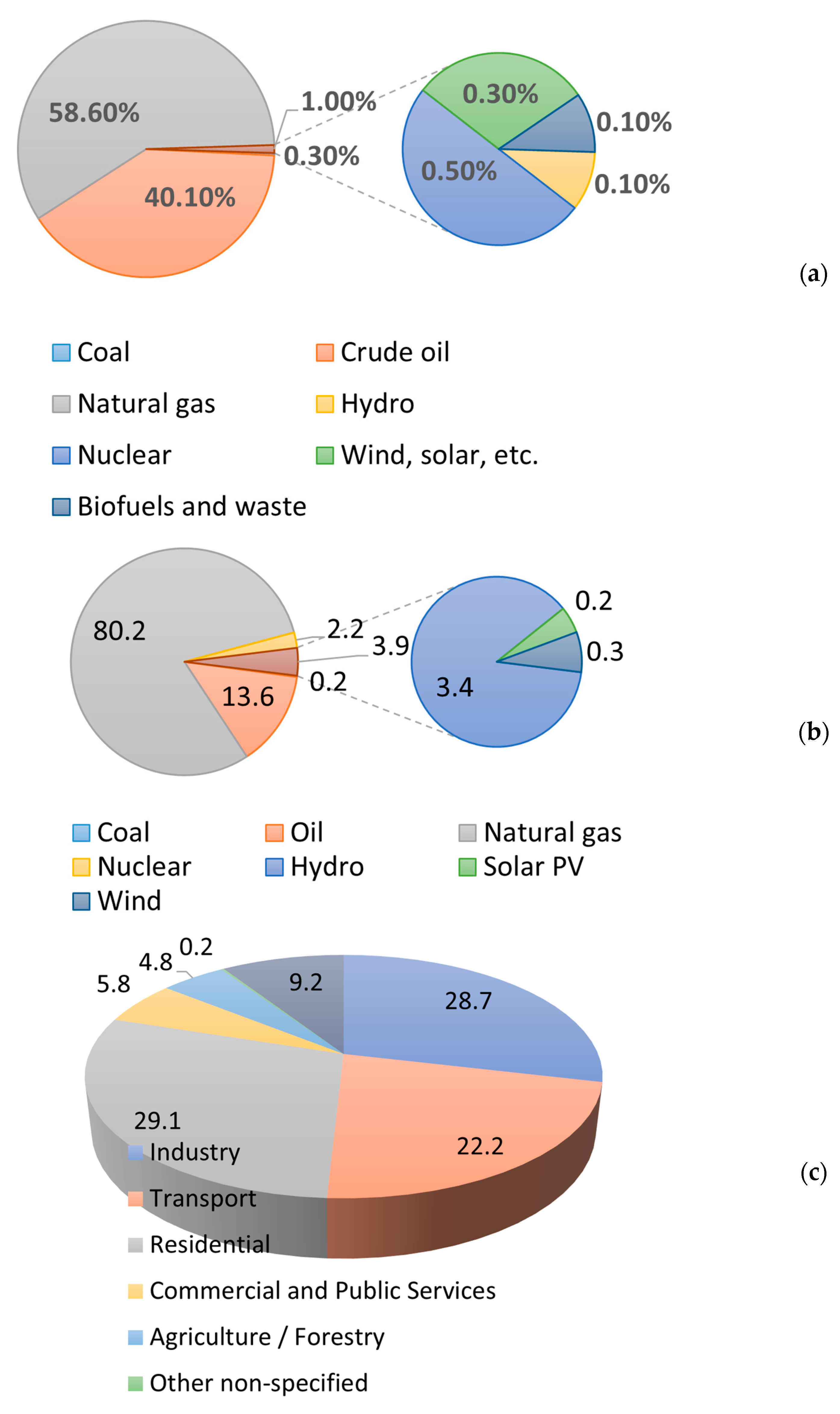
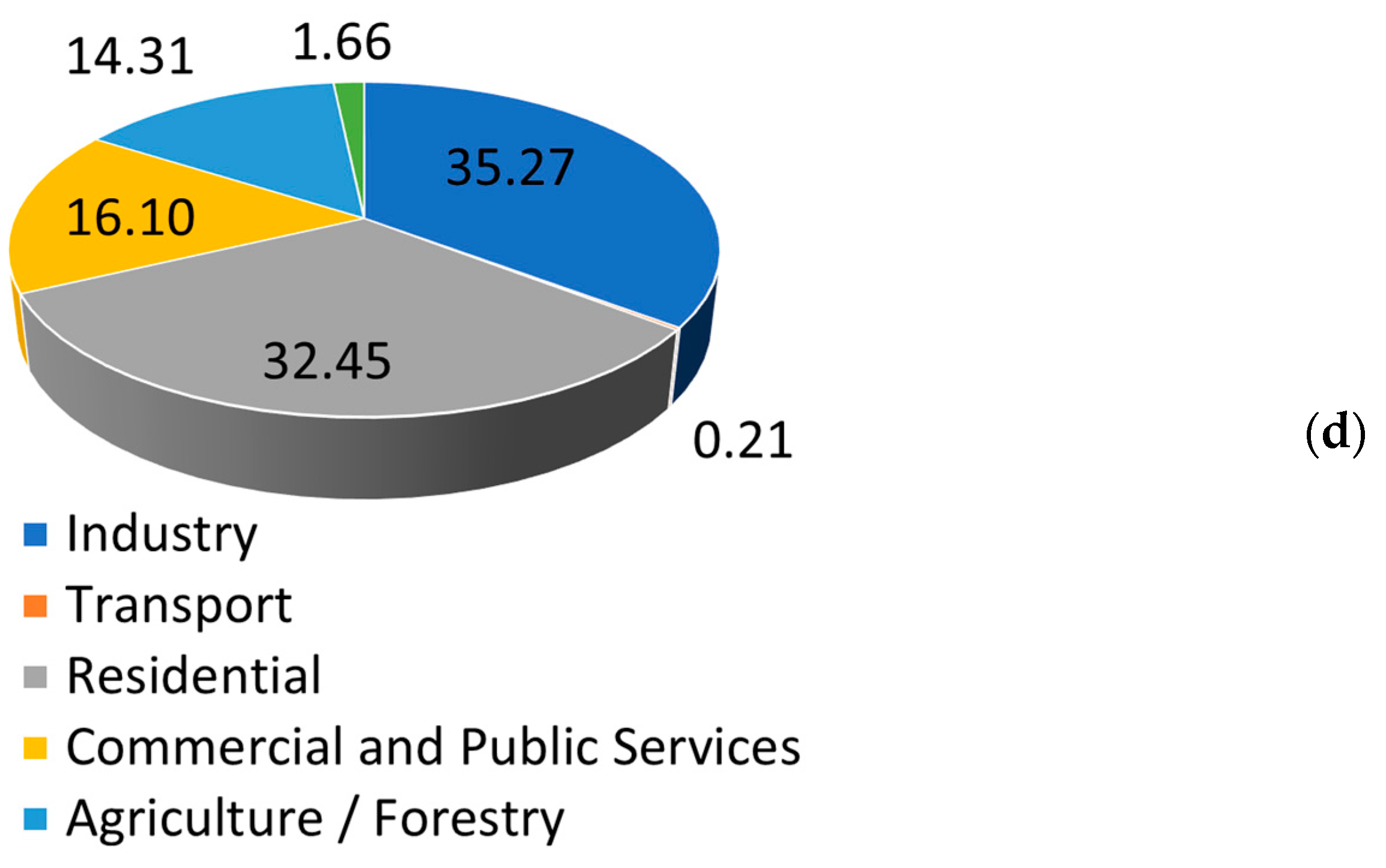
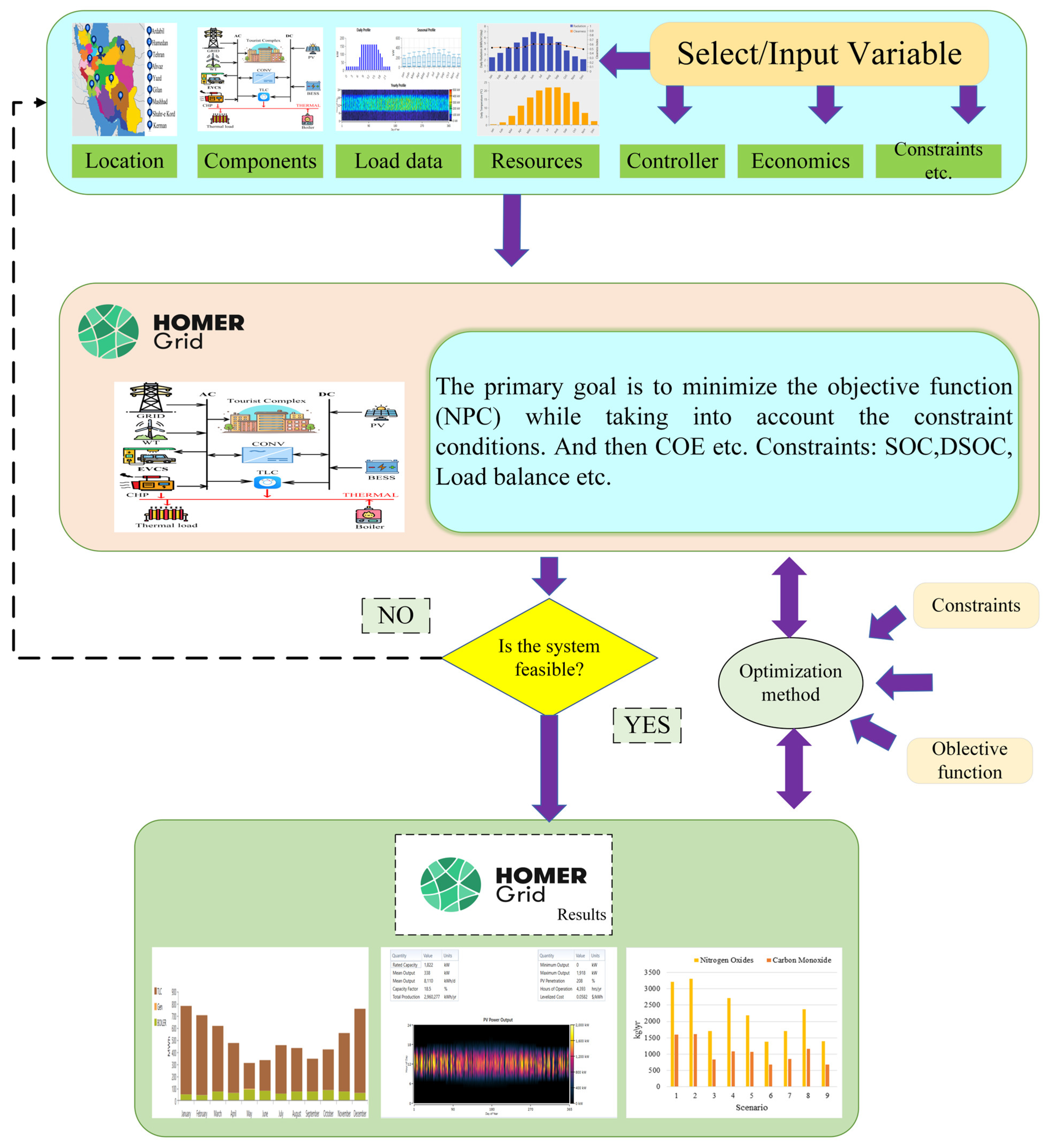
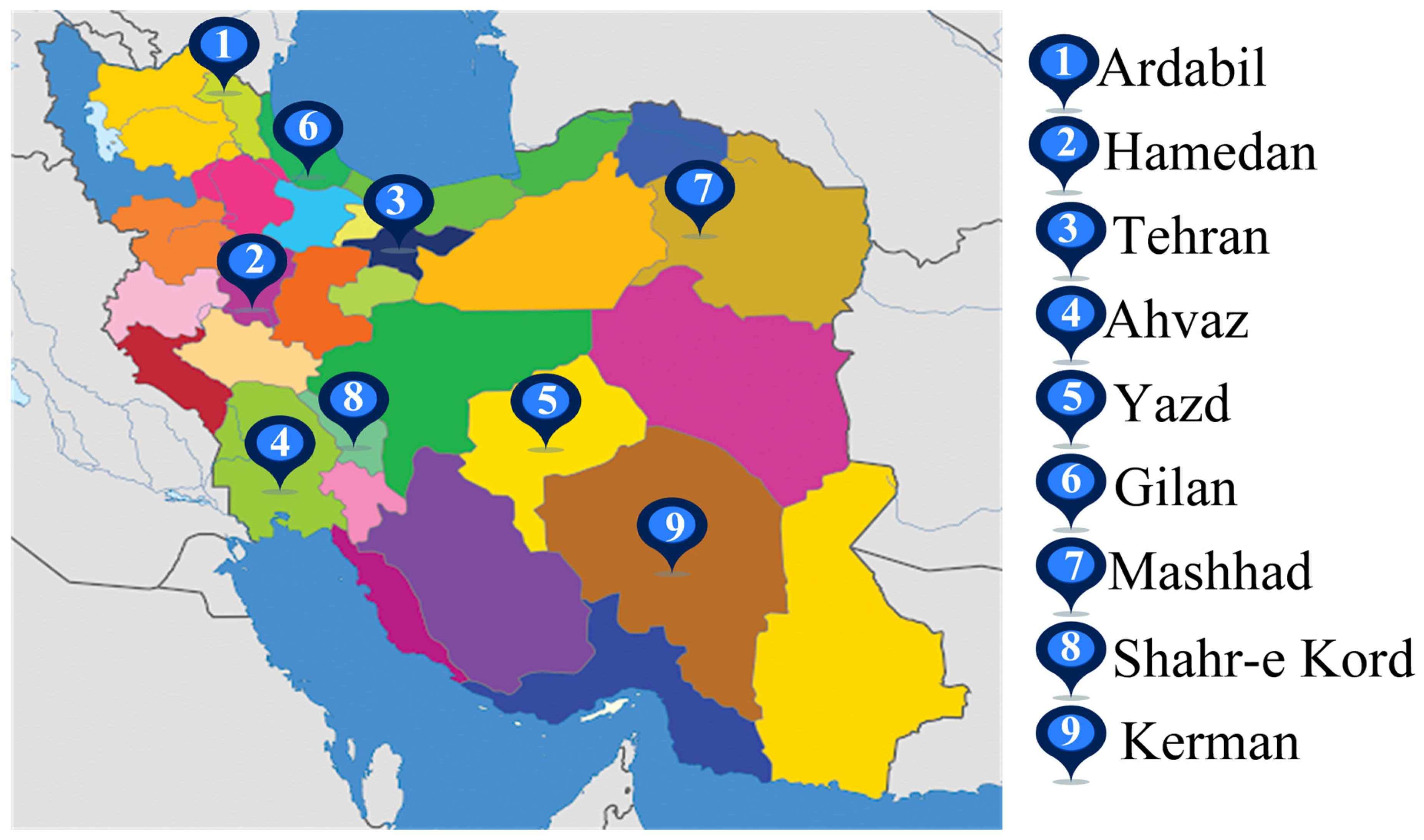
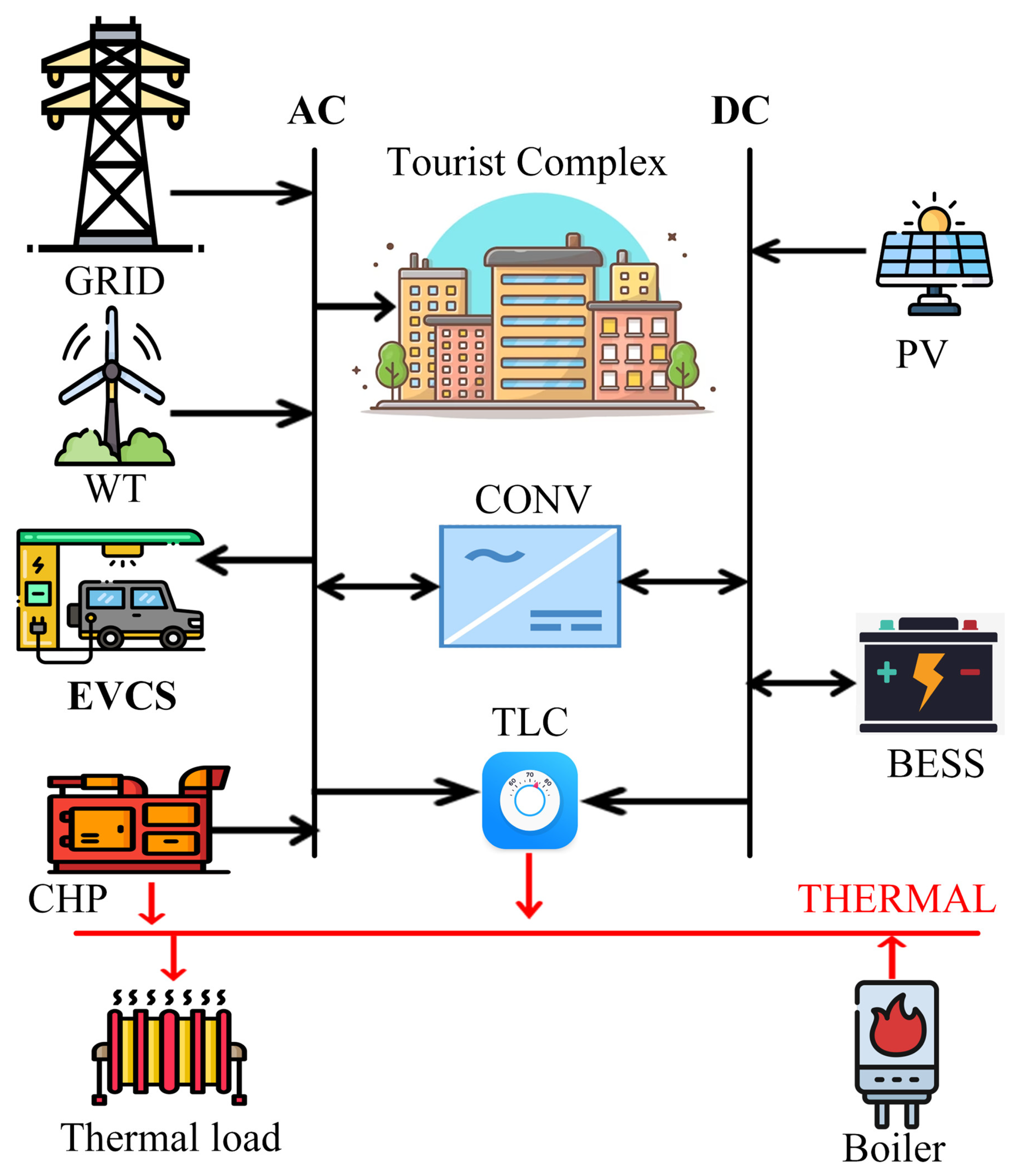


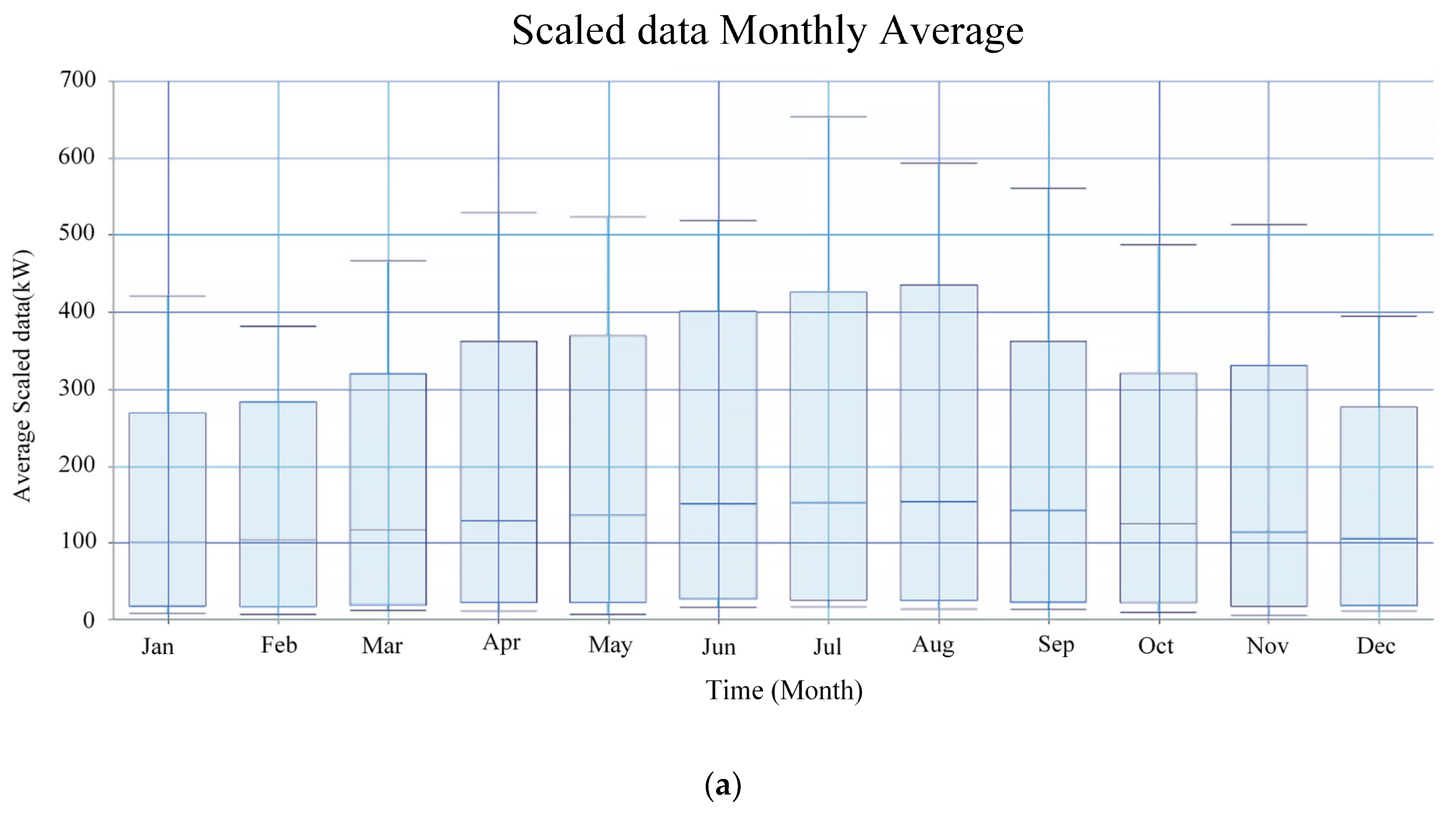
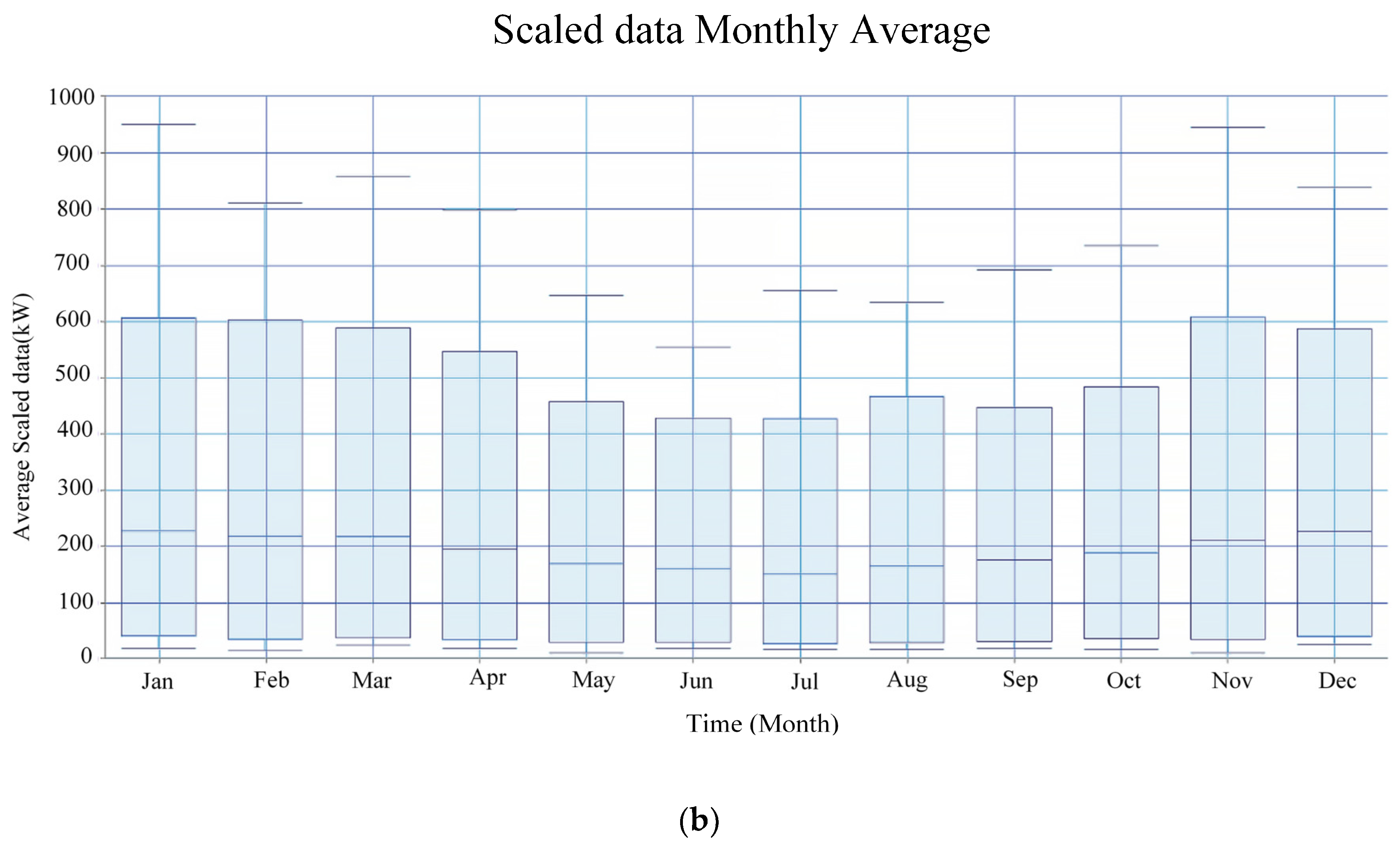
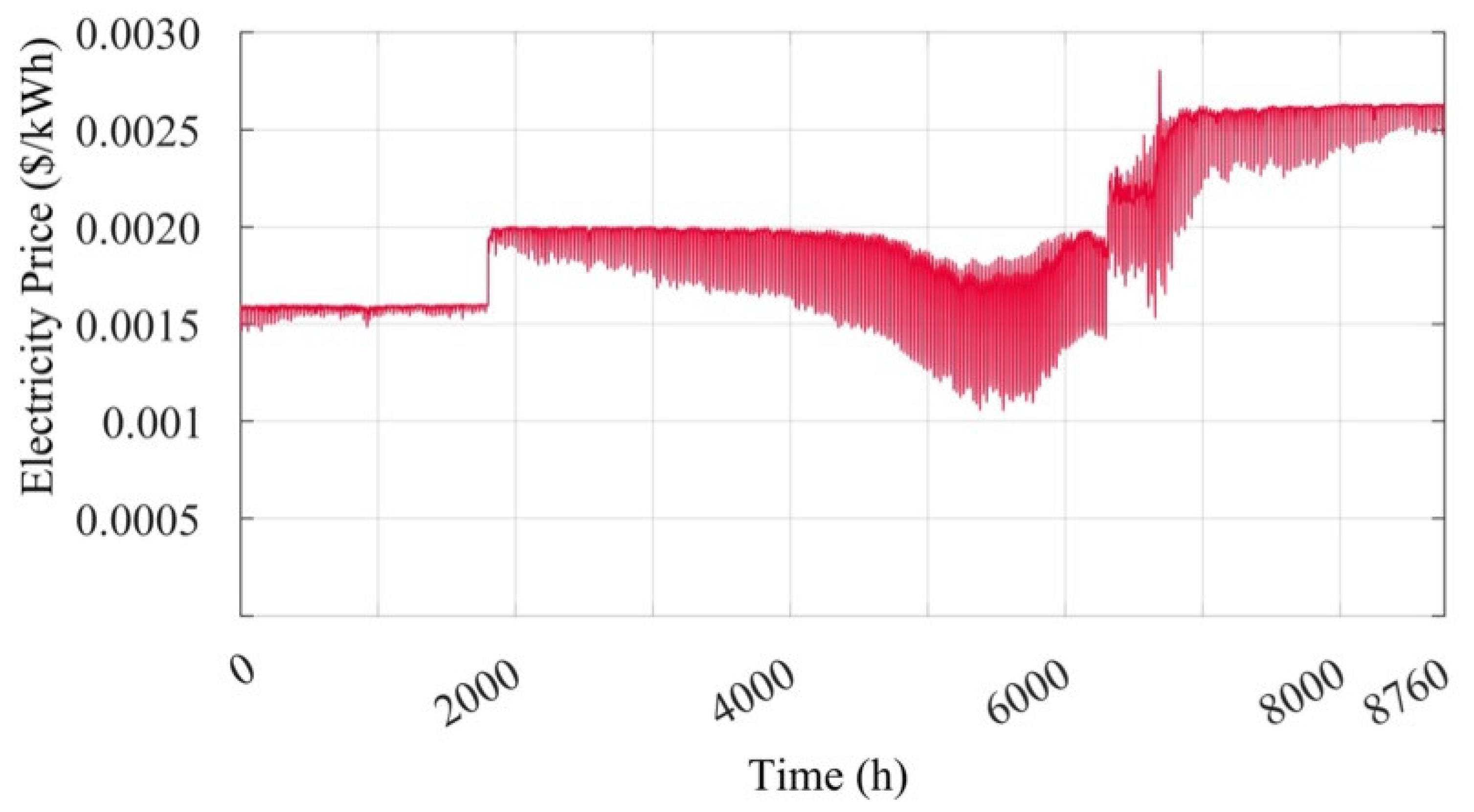
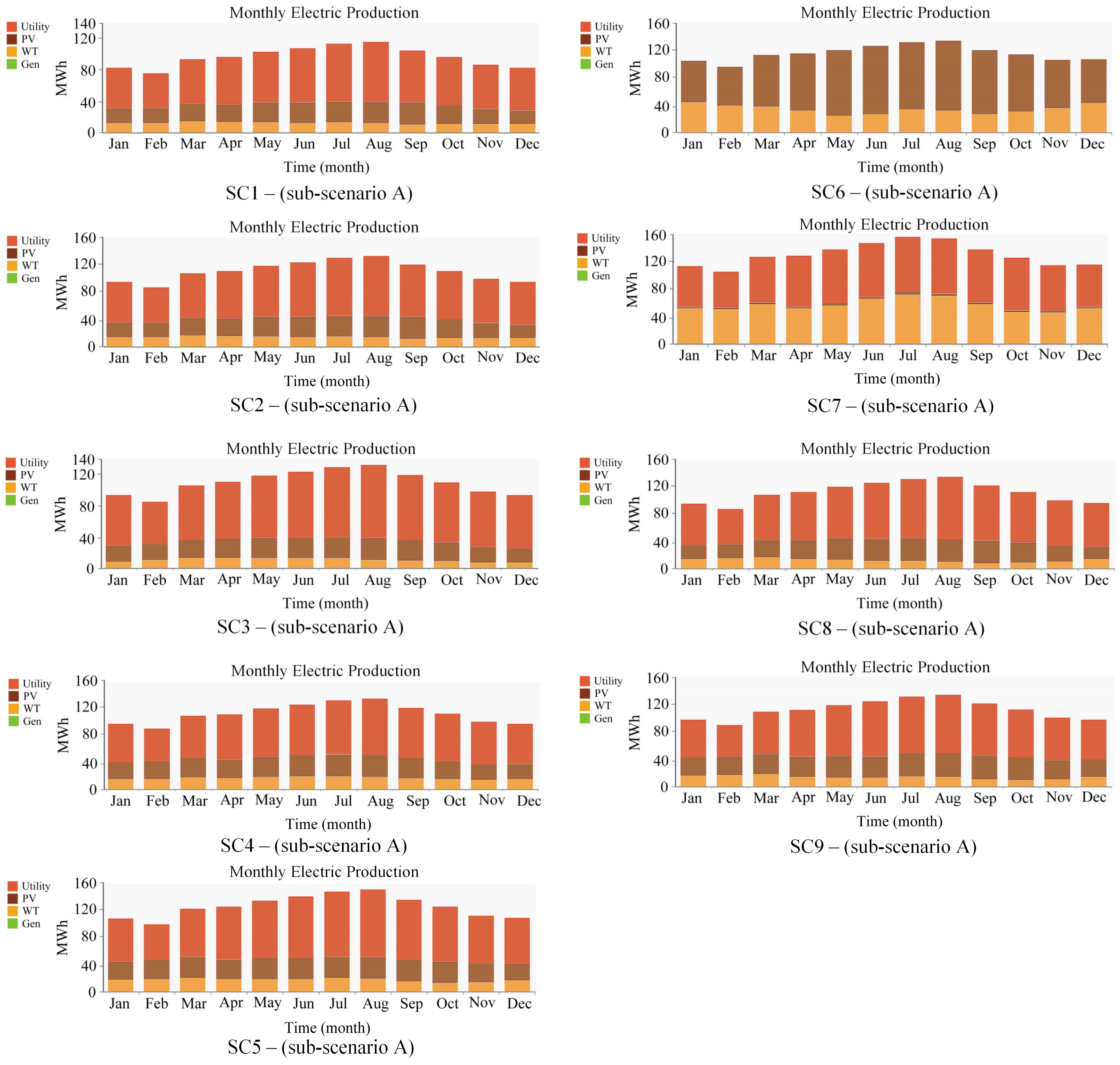
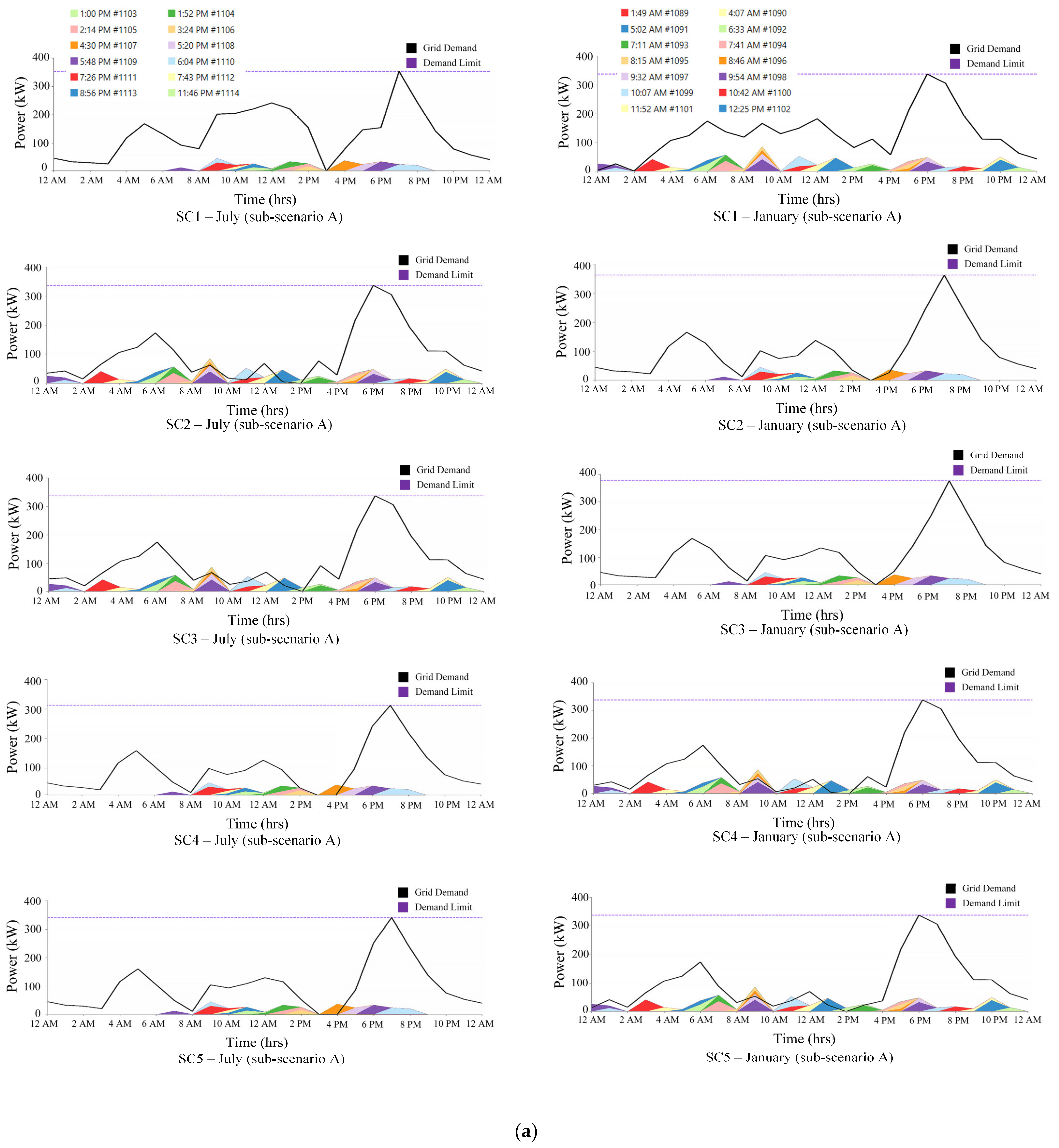
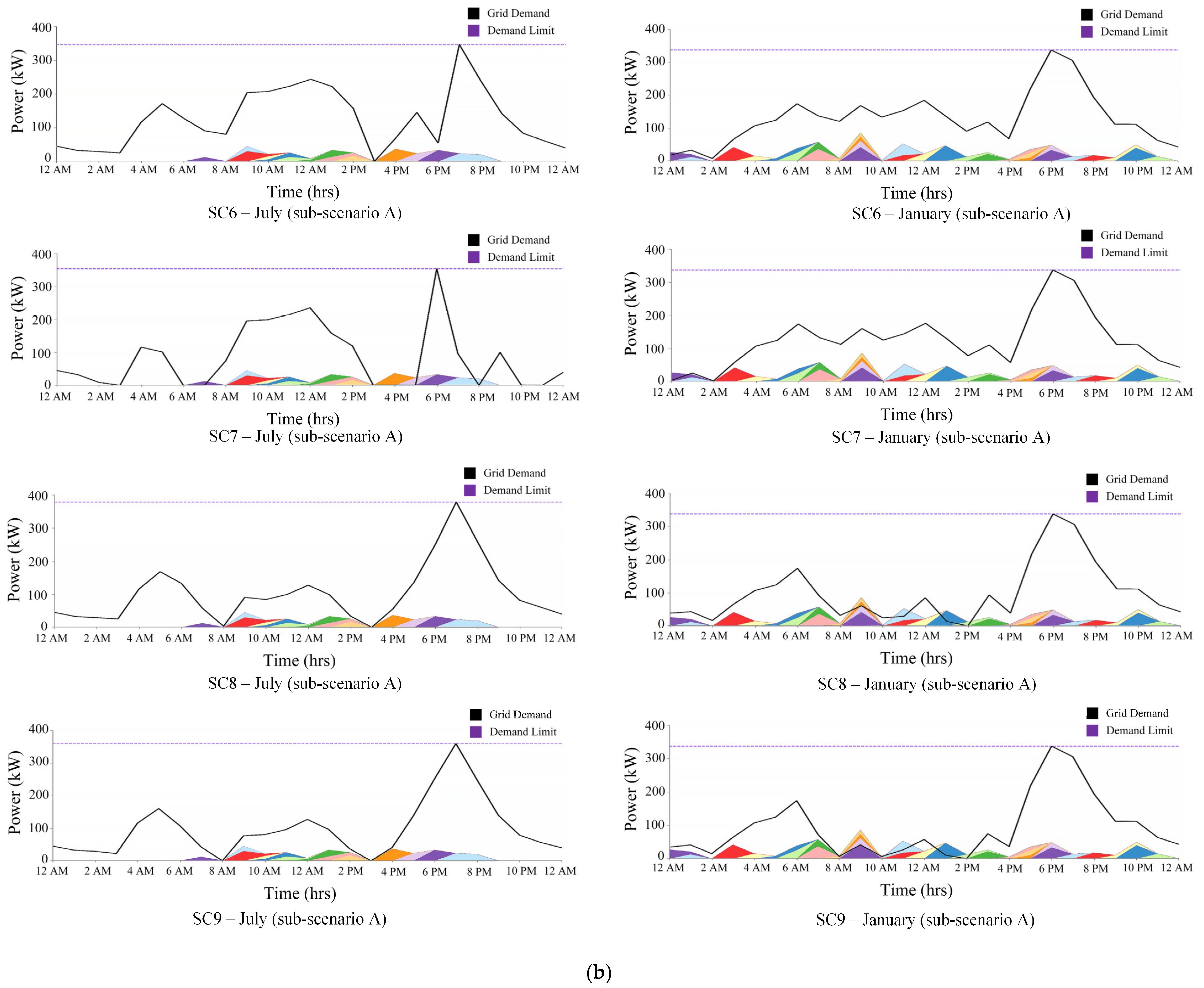
| Ref. | Load Modeling | Hybrid Energy Sources | Storage Devices | Thermal Devices | Economic | Environment | DRP | SOLVER | |||||||
|---|---|---|---|---|---|---|---|---|---|---|---|---|---|---|---|
| Electric | Thermal | EVCS | PV | WT | DG | CHP | BESS | Flywheel | Boiler | TLC | |||||
| [36] | ✓ | ✓ | × | ✓ | ✓ | × | ✓ | × | ✓ | × | ✓ | ✓ | × | HOMER | |
| [41] | ✓ | ✓ | × | ✓ | ✓ | × | × | × | ✓ | ✓ | × | × | TLBO-CSA | ||
| [33] | ✓ | × | × | ✓ | ✓ | ✓ | × | ✓ | × | × | × | ✓ | × | × | PSO-HOMER |
| [34] | ✓ | ✓ | × | ✓ | ✓ | ✓ | × | ✓ | × | × | ✓ | × | × | × | GA-HOMER |
| [35] | ✓ | ✓ | × | ✓ | ✓ | × | × | ✓ | × | × | × | ✓ | × | × | HOMER |
| [37] | ✓ | ✓ | × | ✓ | ✓ | × | ✓ | ✓ | × | ✓ | ✓ | ✓ | ✓ | × | HOMER |
| [38] | ✓ | ✓ | × | ✓ | ✓ | × | ✓ | ✓ | × | ✓ | ✓ | ✓ | ✓ | × | HA |
| [47] | ✓ | × | ✓ | ✓ | × | × | ✓ | × | × | × | ✓ | ✓ | × | HOMER | |
| [48] | ✓ | × | ✓ | ✓ | ✓ | × | × | ✓ | × | × | × | ✓ | × | × | MOPSO |
| [49] | ✓ | × | ✓ | ✓ | ✓ | × | × | ✓ | × | × | × | ✓ | × | × | HOMER |
| [50] | ✓ | × | ✓ | ✓ | ✓ | ✓ | × | ✓ | × | × | × | ✓ | × | × | HOMER |
| [52] | ✓ | ✓ | ✓ | ✓ | ✓ | × | × | × | × | × | ✓ | × | × | × | GWO-SCA |
| [53] | ✓ | × | ✓ | ✓ | ✓ | × | × | ✓ | × | × | × | × | × | × | MSSA |
| [54] | ✓ | × | ✓ | ✓ | ✓ | × | × | ✓ | × | × | × | ✓ | × | × | HOMER |
| [56] | ✓ | × | ✓ | ✓ | × | × | ✓ | × | × | × | ✓ | ✓ | × | MOGA-MILP | |
| [57] | ✓ | × | ✓ | ✓ | ✓ | ✓ | × | ✓ | × | × | × | ✓ | ✓ | × | HOMER |
| [58] | ✓ | × | ✓ | ✓ | ✓ | ✓ | × | ✓ | × | × | × | ✓ | ✓ | ✓ | HOMER-MOPSO |
| [59] | ✓ | × | ✓ | ✓ | × | × | × | ✓ | × | × | ✓ | × | × | MILP | |
| [60] | ✓ | × | ✓ | ✓ | × | × | × | ✓ | × | × | × | ✓ | × | × | HOMER |
| [62] | ✓ | × | ✓ | ✓ | ✓ | ✓ | × | ✓ | × | ✓ | × | ✓ | ✓ | ✓ | HOMER |
| This study | ✓ | ✓ | ✓ | ✓ | ✓ | ✓ | ✓ | ✓ | × | ✓ | ✓ | ✓ | ✓ | × | HOMER |
| Maintenance Intervals (Operating Hours) | 250 | 500 | 1000 | 3000 | 4000 |
|---|---|---|---|---|---|
| Downtime (Hour) | 2 | 0.5 | 1 | 1 | 1 |
| Parameter | Charger Output Power | Number of Chargers | Average Charging Duration | Scaled Average Session PER Day |
|---|---|---|---|---|
| Value | 50 kW | 10 | 0.3 h | 20 |
| Parameter | Value | Ref. |
|---|---|---|
| Inflation rate [%] | 18 | [65] |
| Discount rate [%] | 17.5 | [65] |
| Project lifetime [year] | 25 | - |
| Components | Type | Capital Cost ($) | Replacement Cost ($) | O&M Cost ($) | Life Time (Year) | Ref. |
|---|---|---|---|---|---|---|
| PV | Flat plate PV | 1073 | 1073 | 10 | 25 | [75] |
| BESS | 1 kWh Lead Acid | 300 | 2100 | 25 | 10 | [75] |
| WT | XANT-M-21-100 kW | 210,000 | 210,000 | 3500 | 25 | [39] |
| CHP | Auto size Genset | 428 | 357 | 2 | 15,000 h | [73] |
| CONVERTER | System converter | 530 | 474 | 11.3 | 15 | [39] |
| Component | Parameter | Value |
|---|---|---|
| Flat plate PV | Nominal operation cell temperature | 47 °C |
| Temperature coefficient | −0.5%/°C | |
| Efficiency at standard test condition | 13% | |
| Derating factor | 80% | |
| Generic 1 kWh Li-Ion [ASM] | Nominal capacity | 1020 AH |
| Round trip efficiency | 80% | |
| Max charge current | 270 A | |
| Max discharge current | 810 A | |
| Minimum state of charge | 20% | |
| XANT-M-21-100 kW | Rotor diameter (m) | 21 m |
| Rated capacity | 100 kW | |
| Hub height | 35 m | |
| Cut-in wind speed | 3 m/s | |
| Cut-out wind speed | 20 m/s | |
| Autosize Genset | Min load ratio | 25% |
| Fuel curve slope | 0.236 m3/h/kW | |
| Fuel curve intercept | 13.1 m3/h | |
| CHP Heat Recovery Ratio | 80% | |
| Minimum Runtime | 30 min | |
| System converts | Inverter efficiency | 95% |
| Rectifier efficiency | 95% | |
| Rectifier capacity | 100% | |
| Generic boiler | Efficiency | 85% |
| Capacity (kW) | Capital Cost ($) | Replacement Cost ($) | O&M ($/Year) |
|---|---|---|---|
| 5 | 5365 | 5365 | 100 |
| 10 | 9979 | 9979 | 180 |
| 1000 | 708,180 | 708,180 | 1500 |
| 2000 | 1,158,840 | 1,158,840 | 3000 |
| Capacity (kW) | Capital Cost ($) | Replacement Cost ($) | O&M ($/Year) |
|---|---|---|---|
| 5 | 3500 | 3500 | 0 |
| 10 | 7000 | 7000 | 0 |
| 200 | 110,000 | 110,000 | 1800 |
| 2000 | 850,000 | 850,000 | 16,000 |
| 8000 | 3,200,000 | 3,200,000 | 64,000 |
| 16,000 | 6,000,000 | 6,000,000 | 112,000 |
| Parameter | DG | Boiler | Unit |
|---|---|---|---|
| Carbon monoxide | 6.42 | 4.4 | g/m3 of fuel |
| Particulate matter | 0.181 | 0.04 | g/m3 of fuel |
| Nitrogen oxides | 13.47 | 12 | g/m3 of fuel |
| Parameter | DG | Unit |
|---|---|---|
| Carbon dioxide | 632 | g/kWh |
| Sulfur dioxide | 2.74 | g/kWh |
| Nitrogen oxides | 1.34 | g/kWh |
| Scenario Number | Renewable Fraction (%) | PV (kW) | WT 100 kW (Qty.) | Diesel (kW) | BESS (Qty.) | Converter | COE ($/kWh) | Initial Capital (M$) | Operating Cost ($/year) | NPC (M$) | |
|---|---|---|---|---|---|---|---|---|---|---|---|
| SC1 | A | 12.4 | 4.87 | 2 | 1.4 | 20 | 3.17 | 0.0423 | 1.31 | 24,030 | 1.69 |
| B | 17.8 | 4.58 | 1 | 1.4 | 21 | 2.28 | 0.0497 | 0.646 | 40,483 | 1.72 | |
| C | 10.4 | 262 | - | 1.4 | 24 | 146 | 0.0470 | 0.586 | 41,302 | 1.76 | |
| SC2 | A | 15.8 | 194 | 1 | 1.4 | 4 | 140 | 0.0487 | 1.3 | 20,890 | 1.78 |
| B | 16.1 | 204 | 1 | 1.4 | 10 | 133 | 0.0474 | 0.716 | 41,409 | 1.68 | |
| C | 14.9 | 290 | - | 1.4 | 22 | 219 | 0.0459 | 0.656 | 41,577 | 1.76 | |
| SC3 | A | 13.3 | 178 | 1 | 1.4 | 20 | 116 | 0.0511 | 1.28 | 23,774 | 1.91 |
| B | 14.6 | 204 | 1 | 1.4 | 21 | 133 | 0.0497 | 0.721 | 41,448 | 1.87 | |
| C | 10.2 | 224 | - | 1.4 | 10 | 131 | 0.0444 | 0.508 | 42,774 | 1.69 | |
| SC4 | A | 17.1 | 191 | 1 | 1.4 | 40 | 114 | 0.0471 | 1.28 | 22,180 | 1.8 |
| B | 17.1 | 204 | 1 | 1.4 | 10 | 116 | 0.0465 | 0.716 | 40,394 | 1.78 | |
| C | 10.3 | 234 | - | 1.4 | 13 | 127 | 0.0447 | 0.523 | 41,533 | 1.70 | |
| SC5 | A | 16.3 | 175 | 1 | 1.4 | 80 | 114 | 0.0471 | 1.27 | 19,986 | 1.80 |
| B | 17.5 | 195 | 1 | 1.4 | 81 | 127 | 0.0499 | 0.739 | 43,136 | 1.88 | |
| C | 15.4 | 245 | - | 1.4 | 103 | 148 | 0.0468 | 0.686 | 43,181 | 1.75 | |
| SC6 | A | 13.5 | 10 | 3 | 1.4 | 20 | 10 | 0.0473 | 1.25 | 25,514 | 1.83 |
| B | 14.4 | 16.1 | 3 | 1.4 | 46 | 15 | 0.0431 | 0.687 | 35,846 | 1.77 | |
| C | 11.6 | 244 | - | 1.4 | 162 | 169 | 0.0510 | 0.653 | 40,785 | 1.89 | |
| SC7 | A | 21.6 | 35.3 | 3 | 1.4 | 47 | 19 | 0.0418 | 1.35 | 25,370 | 1.93 |
| B | 22.7 | 45.2 | 3 | 1.4 | 53 | 22.1 | 0.0405 | 0.887 | 34,879 | 1.81 | |
| C | 10.6 | 205 | - | 1.4 | 90 | 146 | 0.0473 | 0.556 | 40,573 | 1.76 | |
| SC8 | A | 14.9 | 209 | 1 | 1.4 | 35 | 123 | 0.0492 | 1.3 | 31,212 | 1.87 |
| B | 16.2 | 233 | 1 | 1.4 | 80 | 141 | 0.0477 | 0.746 | 40,728 | 1.82 | |
| C | 15.1 | 312 | - | 1.4 | 88 | 203 | 0.0444 | 0.658 | 39,847 | 1.71 | |
| SC9 | A | 16.5 | 214 | 1 | 1.4 | 64 | 127 | 0.0479 | 1.32 | 19,501 | 1.83 |
| B | 17.6 | 260 | 1 | 1.4 | 91 | 169 | 0.0466 | 0.769 | 38,862 | 1.80 | |
| C | 16.7 | 312 | - | 1.4 | 126 | 305 | 0.0455 | 0.712 | 40,366 | 1.78 | |
Disclaimer/Publisher’s Note: The statements, opinions and data contained in all publications are solely those of the individual author(s) and contributor(s) and not of MDPI and/or the editor(s). MDPI and/or the editor(s) disclaim responsibility for any injury to people or property resulting from any ideas, methods, instructions or products referred to in the content. |
© 2025 by the authors. Licensee MDPI, Basel, Switzerland. This article is an open access article distributed under the terms and conditions of the Creative Commons Attribution (CC BY) license (https://creativecommons.org/licenses/by/4.0/).
Share and Cite
Kiani, H.; Vahidi, B.; Hosseinian, S.H.; Lazaroiu, G.C.; Siano, P. Prospective Design and Evaluation of a Renewable Energy Hybrid System to Supply Electrical and Thermal Loads Simultaneously with an Electric Vehicle Charging Station for Different Weather Conditions in Iran. Smart Cities 2025, 8, 61. https://doi.org/10.3390/smartcities8020061
Kiani H, Vahidi B, Hosseinian SH, Lazaroiu GC, Siano P. Prospective Design and Evaluation of a Renewable Energy Hybrid System to Supply Electrical and Thermal Loads Simultaneously with an Electric Vehicle Charging Station for Different Weather Conditions in Iran. Smart Cities. 2025; 8(2):61. https://doi.org/10.3390/smartcities8020061
Chicago/Turabian StyleKiani, Hossein, Behrooz Vahidi, Seyed Hossein Hosseinian, George Cristian Lazaroiu, and Pierluigi Siano. 2025. "Prospective Design and Evaluation of a Renewable Energy Hybrid System to Supply Electrical and Thermal Loads Simultaneously with an Electric Vehicle Charging Station for Different Weather Conditions in Iran" Smart Cities 8, no. 2: 61. https://doi.org/10.3390/smartcities8020061
APA StyleKiani, H., Vahidi, B., Hosseinian, S. H., Lazaroiu, G. C., & Siano, P. (2025). Prospective Design and Evaluation of a Renewable Energy Hybrid System to Supply Electrical and Thermal Loads Simultaneously with an Electric Vehicle Charging Station for Different Weather Conditions in Iran. Smart Cities, 8(2), 61. https://doi.org/10.3390/smartcities8020061








